Planting and Care Guide
Follow our planting and care guides below and you’ll bet set up for landscape and garden success.
Have a specific question and you like to research online? The future has come for gardeners to have an AI chat for plant and gardening questions! https://mastergardener.libraria.dev
It’s the Root of the Matter
The top priority, when you get a new landscape plant, is to make sure they develop a strong root system. When the plant has a robust root system, the plant can handle environmental stressors, uptake nutrients, and overcome disease and insect damage easier.
After the plant has developed a robust root system, the plant is considered established.
The establishment time depends on the size of the plant and variety.
These are average establishment times.
Perennials: 1 to 2 years
Shrubs: 2 to 3 years
Trees: 2 to 4 years
Let’s Dig In
- Handle With Care: Always lift plants by their root ball. Never lift by the trunk or drag the plant. Keep roots moist (not soggy), to reduce stress on the plant prior to planting.
- Properly Dig Holes: Holes should be the same depth as the root ball and about two to three times as wide to allow for proper growth of the root system. If the hole is too deep, the plant can sink, creating a depression in the ground for standing water to collect. This will lead to problems over time.
- Filling With Soil: Once the plant is in place, remove plastic containers, mesh, twine, or burlap and backfill the hole with native soil. Once the hole is halfway full, water can be added to help close any air pockets. After the water drains, check to make sure the plant is straight. Fill the rest of the hole and lightly pack. Water the soil again to help settle and close air pockets.
- Adding Mulch: Proper amounts of mulch will help the roots retain moisture and help reduce manual watering. Put down a couple inches around perennials and annuals to retain moisture. Leave 2″-3″ open with no mulch around the base of the plant. Use a three inch thick layer of mulch for trees and shrubs and begin taper off as you near the trunk. Imagine a doughnut shape of mulch around your plant to create a central reservoir that traps water in a circle around the root zone to help retain water when you are manually watering. Avoid creating a “mulch volcano” as this can lead to disease and rot around the base of the trunk.
- Watering: Newly planted plants can be killed by over- and under- watering. The only area the new plant is getting water is in the root ball area until it grows new roots into your soil. Keeping this root ball moist, not soggy, is one of the most important things to keep your plant healthy.
The best way to ensure your plant is receiving proper amounts of water is to stick your finger a few inches in the soil near your plant. If the soil is damp and sticks to your finger, there’s enough water. The general guide is 1 inch of water a week, including rain.
Tip for watering trees: Get a 5-gallon bucket, drill 1/8 inch holes near the bottom, fill with water and place it next to the tree. Do this once every week or tw
- Protection: Tree saplings have tender bark and need extra protection until they toughen up. The tender bark is also a preferred meal to animals like deer and rabbit. To avoid animal damage that can kill your tree, get a open mesh tree guard to provide year round protection and use animal repellents. At the end of October, wrap your tree to prevent issues like sun scald and frost crack. Watch our video below about wrapping your trees as well as evergreens!
Animals: A variety of shrubs, trees, and perennials are animal resistant but no plant is safe from a very hungry animal. If animals snack on a small branch or buds, it’s not going to kill your plant. However, if they eat through the inner bark, the phloem, and around the entire diameter, then the plant won’t be able take up nutrients.
Read an online version of our nursery stock winter hardiness guarantee.
Visit our Resources page for additional care information and resources!
FAQs Filter
-
- When watering during the first season you plant, it is best to water less frequently BUT thoroughly than to water more frequently and in small amounts. Usually, with well-drained soil, 1-inch of water every 7-10 days should be sufficient; for a heavy soil, every 14 days. If you have questions on specific plant varieties and soil types, please call any time. After the first season, in most cases, water will not be needed unless you have drought conditions and in fall (see #3).
- We recommend newly planted trees be wrapped with white protective tree wrap late in the fall to help protect against sun scald and rodent and rabbit damage during winter. Remove wrap in the spring. This practice should be continued every year until the bark begins to roughen. The wrap should extend from the ground up to the first tier of branches. Fiber reinforced tape works best to hold up the wrap.
- It is very important all trees and shrubs go into winter with ample moisture. If there has been adequate rainfall during fall the amount of watering will be less. It is especially important that all evergreens are watered well late into the fall. You will want your landscape plants to get an inch of water a week in the fall. Measure with a rain gauge. If you don’t get an inch of rain a week, you will need to water. The best practice is to water a wide area with a sprinkler.
-
Asparagus can be planted as soon as the ground is workable in spring. Asparagus is a perennial vegetable so it comes back year after year. The fern-like stalks will grow up to 6’ tall. While asparagus may use more space and take about 3 years to come into full production, they ultimately pay off, providing spears for 15–20 years in spring.
Download our Planting Asparagus pdf for full instructions.
-
We have a winter hardiness warranty on our trees, shrubs, and vines (ex: virginia creeper, trumpet vine, grapes) out in the nursery lot.
When you purchase a plant under winter hardiness warranty it does not cover loss for the season due to lack of care, extreme weather events, animal damage, or mechanical damage.
You will receive a copy of a nursery stock guarantee whenever you purchase plants under warranty.
If you are concerned about the health of the plant you are purchasing please bring it up to a manager and mention your concern. We will not honor plant returns if you think the plant is not in good condition when you purchase. If you are concerned we recommend choosing a different plant.
In regards to annuals and perennials, if you purchase one of these plants and they are in the same condition as they left the store and not planted we were accept returns.generally within a week.
-
Diagnostic tool from the University of Minnesota Extension Service.
-
Dig a hole twice as wide as the pot but no deeper. The root ball should rest on a solid soil foundation. Remove the container before you plant, carefully handling the root ball. A broken root ball can mean a dead plant. Handle the plant by the root ball and not the trunk when carefully placing it in the hole.
Backfill the hole using mostly the native soil removed from the hole using a small amount of compost. At this time ensure the top of the root ball is slightly above soil level to allow for settling. Never plant the root ball below the soil level or it will mean death to the plant. Fill the hole and firm the soil around the plant. Water thoroughly to settle the soil around the roots and to eliminate any air pockets.
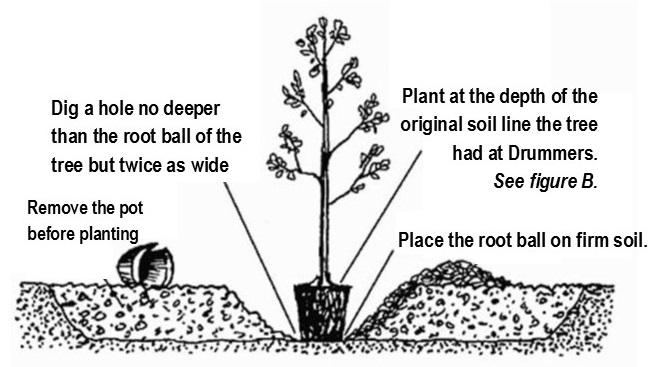
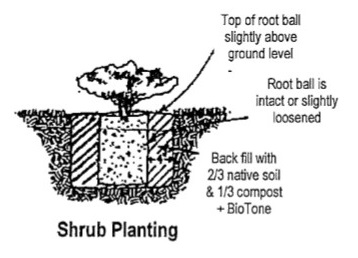
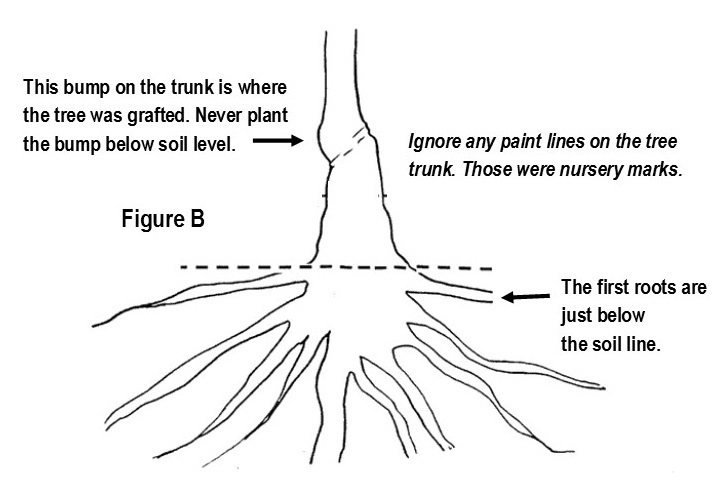
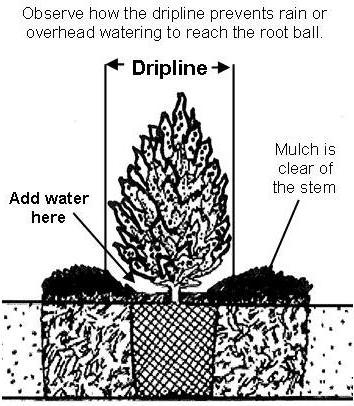

It’s a good idea to use Root & Grow, a root stimulant, with this first watering. However, do not fertilize until next spring. It is also beneficial to use Espoma Bio Tone Starter Plus as a starter supplement.
Before calling it a day, add up to 4-inches of mulch around the base of the plant. Avoid the trunk as a “mulch volcano” will do major damage to your investment. Mulch helps keep down weeds and conserves soil moisture. -
*If you are not going to plant immediately, store your plants in the shade and check frequently for moisture. On hot days, you may need to water them more than once a day.
After planting, check daily for moisture. The top of the soil will be dry so check by sticking your finger down into the soil approximately 1– to 3-inches to check for moisture. If moisture is present, don’t water. Just as too little water will cause the plant to die so will too much water. More trees and shrubs fail due to over watering than under-watering.
The warmer the weather, the more often watering may be needed. The smaller the plant’s original root ball, the more moisture it may need until it gets established. Usually it takes 2-3 weeks for a plant to get established. Please see item #2 above in the tree section. The amount of sun and wind the shrub is getting will also determine how quickly it will dry out. If you have any questions about these procedures, please feel free to call us. -
We recommend newly planted trees be wrapped with a white protective tree wrap late in the fall to help protect against sun scald and rodent and rabbit damage during winter. Remove wrap in the spring. This practice should be continued every year until the bark begins to roughen. The wrap should extend from the ground up to the first tier of branches. Fiber reinforced tape works best to hold up the wrap.
It is very important all trees and shrubs go into winter with ample moisture. If there has been adequate rainfall during fall the amount of watering will be less. It is especially important that all evergreens are watered well late into the fall.
When watering during the growing season, it is best to water less frequently BUT thoroughly than to water more frequently and in small amounts. Usually, with well drained soil, one inch of water every 7-10 days should be sufficient; for a heavy soil, every 14 days. If you have questions on specific plant varieties and soil types, please call any time for help and more information.
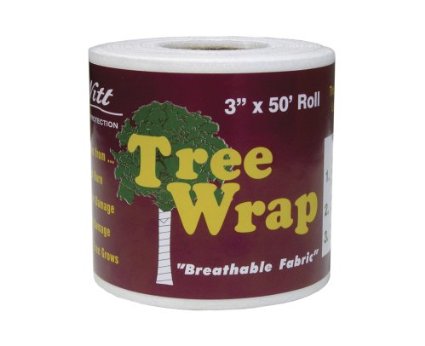
-
Plant your plants as soon as possible after purchase. If you’re not going to plant immediately, store plants in the shade and check frequently for moisture. On hot days, you may need to water them more than once a day.
- Dig a hole twice as wide as the pot but no deeper. It’s a good idea to add Espoma BioTone Starter in the hole as a root stimulator and starter fertilizer. The root ball should rest on a solid soil foundation. Remove the container before you plant, carefully handling the root ball. Handle the plant by the root ball and not the trunk when carefully placing it in the hole.
- Now it’s time to position the root ball properly. Ensure the top of the root ball is slightly above soil level making sure the top roots are just below soil level. Backfill the hole using mostly the native soil removed from the hole combined with a small amount of compost. Firm the soil around the plant. Water thoroughly to settle the soil and to eliminate any air pockets.
- Add up to 4-inches of mulch around the base of the plant avoiding touching the trunk. Mulch helps keep down weeds and conserves soil moisture.
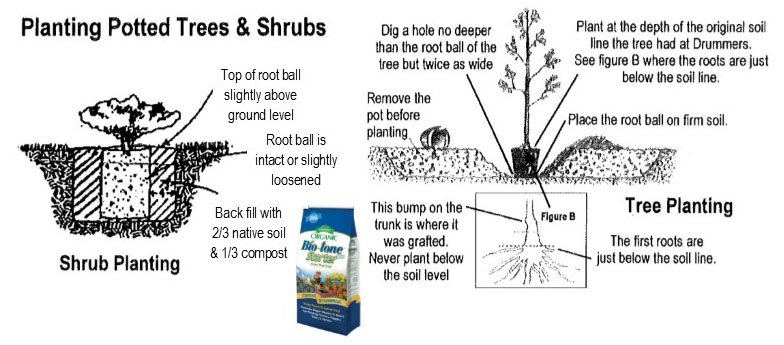
-
- After planting, check daily for moisture. The top of the soil will be dry so check by sticking your finger down into the root ball approximately 1– to 3-inches to check for moisture. If moisture in the root ball is present, don’t water. Just as too little water will cause the plant to die so will too much water. More trees and shrubs fail due to over-watering than under-watering.
- It is critical to get water to the root ball rather than the surrounding soil in order to keep the shrub alive. Even if it rains you will probably need to water because rain will shed off the shrub at the sides of the root ball. (See figure)

- The warmer the weather, the more often watering may be needed. Usually it takes several weeks for a plant to get established. The amount of sun and wind the shrub is getting will also determine how quickly it will dry out. If you have any questions about these procedures, please feel free to call us.
- During the first season you plant, if the soil is dry, continue to water an inch a week through fall. Measure the inch of water with a rain gauge. After the first season, in most cases, water will not be needed unless you have drought conditions and in fall. It is very important all trees and shrubs go into winter with ample moisture. If there has been adequate rainfall during fall the amount of watering will be less. It is especially important that all evergreens are watered well late into the fall. You will want your landscape plants to get an inch of water a week in the fall. Measure with a rain gauge. If you don’t get an inch of rain a week, you will need to water. The best practice is to water a wide area with a sprinkler.
-
Mankato area is Zone 4.
The 2012 USDA Plant Hardiness Zone Map is the standard by which gardeners and growers can determine which plants are most likely to thrive at a location. This map is also interactive.
-
https://www.ipm.iastate.edu/ipm/hortnews/2000/2-11-2000/prunetime.html
PRUNING GUIDE:
EVERGREENS – DURING MONTH OF JUNE AFTER NEW GROWTH HAS APPEARED; NO MORE THAN 1/3 OF PLANT AT A TIME; BE SURE TO GIVE THEM A GOOD THOROUGH SOAKING RIGHT BEFORE THE GROUND FREEZES FOR WINTER
FLOWERING SHRUBS (SPIREA, BARBERRY, WEIGELA, BURNING BUSH, ETC.) – DURING DORMANCY; TYPICALLY DECEMBER 1ST THRU MARCH 15TH. NO MORE THAN ½ OF PLANT AT A TIME; ALSO CAN SHAPE/DEADHEAD AFTER BLOOM HAS FINISHED TO CLEAN THE PLANT UP & PROMOTE NEW GROWTH
NOTES:
SPRING BLOOMING SHRUBS (LILAC, FORSYTHIA, ETC.) – PRUNE AFTER BLOOM IN SPRING HAS FINISHED; TYPICALLY JUNE 1ST-JULY 1ST, THESE PLANTS SET BUD IN FALL FOR SPRING BLOOM, SO PRUNING IN FALL OR WINTER WILL COMPLETELY REMOVE YOUR SPRING BLOOM.
HYDRANGEAS – TYPICALLY LEAVE ALONE EXCEPT FOR DEAD BRANCHES, DROOPING BRANCHES; CLIP DEAD BLOOMS OFF DECEMBER THROUGH MARCH.
LARGE LANDSCAPE SHRUBS (WEIGELA, CRANBERRY BUSH, ETC.) – BE SURE TO PRUNE 1/3 OF OLDEST STEMS OUT EVERY SEASON ONCE ESTABLISHED FOR 5 TO 7 YEARS, THIS WILL ENCOURAGE NEW GROWTH FROM THE BASE, KEEPING THE PLANT FULL AND LEAVED OUT FROM TOP TO BOTTOM.
FLOWERING SHRUBS – ‘WILD HAIRS’ CAN BE CLIPPED BACK ANY TIME DURING GROWING SEASON TO KEEP SHAPE, BARBERRIES ARE A TYPICAL CANDIDATE.
-
Read our blog post about starting a garden!
And Seed Starting!
